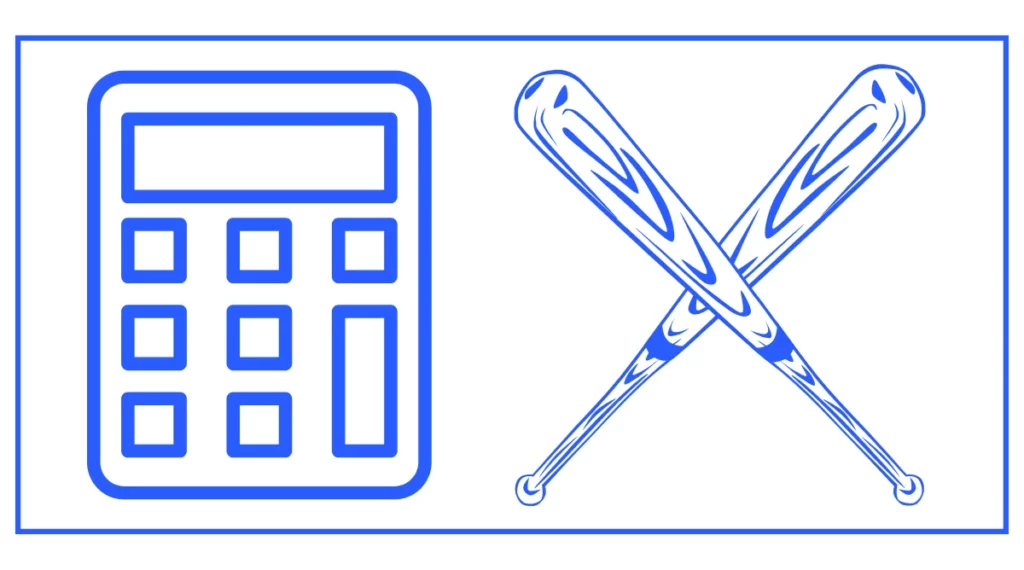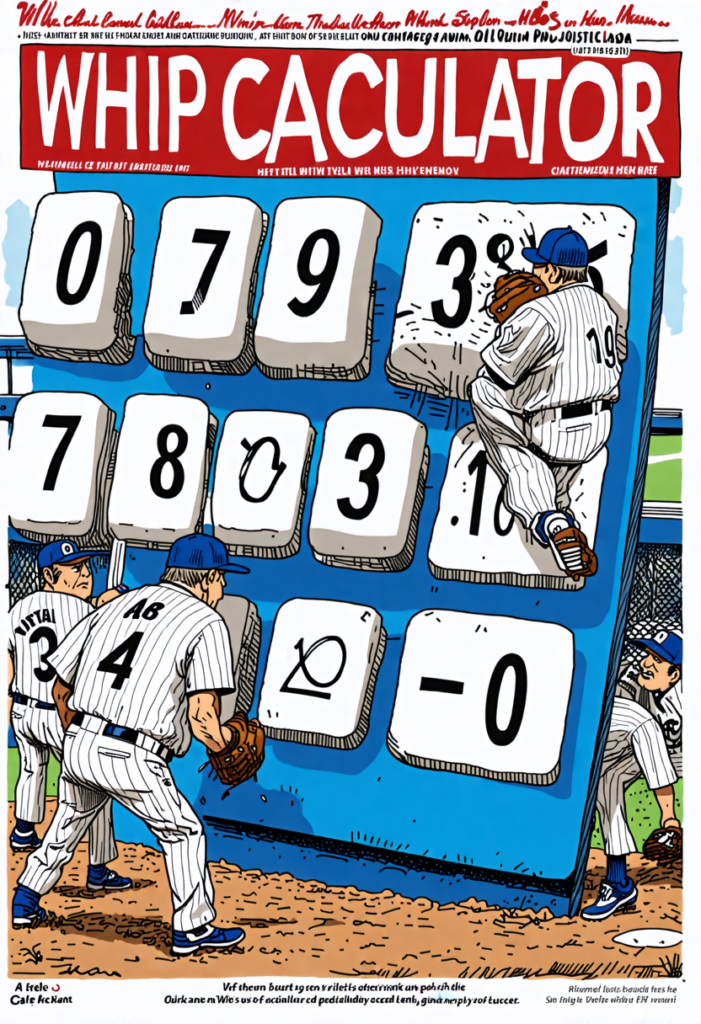Whip Calculator
WHIP (Walks plus Hits per Inning Pitched) is a sabermetric stat that measures how many baserunners a pitcher has given up per inning pitched.
The WHIP is one of the most common ways to judge a pitcher’s skills in baseball.
WHIP calculator helps you find your walk hits per innings pitched.
Enter the number of hits, walks, and innings to find it out.

You might want to calculate your GAA or slugging %.
What is WHIP in baseball?
WHIP, an acronym for “Walks and Hits per Inning Pitched,” is a statistical measure used to evaluate a pitcher’s ability to prevent batters from reaching base. This metric provides insights into a pitcher’s effectiveness by calculating the average number of baserunners allowed per inning.
The WHIP statistic combines two fundamental aspects of pitching:
1. Walks: The number of batters who reach base on balls.
2. Hits: The number of base hits allowed by the pitcher.
By considering both walks and hits, WHIP offers a more comprehensive view of a pitcher’s performance than looking at earned run average (ERA) alone.
The WHIP Formula: How to Calculate WHIP
The formula for calculating WHIP is straightforward:
WHIP = (Walks + Hits) / Innings Pitched
To calculate WHIP, you need three key pieces of information:
1. The number of walks allowed
2. The number of hits allowed
3. The number of innings pitched
For example, if a pitcher has allowed 50 hits and 30 walks over 100 innings pitched, their WHIP would be calculated as follows:
WHIP = (50 + 30) / 100 = 0.80
This means the pitcher allows an average of 0.80 baserunners per inning pitched.
How do I use our WHIP Calculator?
While the WHIP formula is relatively simple, using a WHIP calculator can streamline the process and ensure accuracy. A WHIP calculator is a tool that automates the calculation, allowing you to input the necessary statistics and receive an instant result.
To use our WHIP calculator:
1. Enter the number of hits allowed by the pitcher.
2. Input the number of walks issued.
3. Provide the number of innings pitched.
4. Click the “Calculate” button to generate the WHIP value.
The calculator will then display the pitcher’s WHIP, typically rounded to two decimal places.
Interpreting WHIP Values
Understanding WHIP values is essential for evaluating pitcher performance. Generally, a lower WHIP indicates better performance, as it means the pitcher allows fewer baserunners per inning. Here’s a general guideline for interpreting WHIP values:
Excellent: Below 1.00
Great: 1.00–1.10
Above-average: 1.11–1.20
Average: 1.21–1.30
Below Average: 1.31–1.40
Poor: Above 1.40
It’s important to note that these ranges can vary depending on the league and era. In Major League Baseball, a WHIP below 1.20 is often considered good, while elite pitchers may maintain WHIPs below 1.00 over a season.
The Importance of WHIP in Baseball Analysis
WHIP has become an integral part of baseball analysis for several reasons:
1. Predictive Value: WHIP can be a good indicator of future performance, often correlating well with a pitcher’s ERA.
2. Consistency Measure: It helps assess a pitcher’s ability to consistently prevent baserunners, which is crucial for team success.
3. Complementary Statistic: When used alongside other metrics like ERA, strikeout rate, and ground ball percentage, WHIP provides a more comprehensive picture of a pitcher’s effectiveness.
4. Comparative Tool: WHIP allows for easy comparison between pitchers, helping teams and analysts evaluate talent.
Limitations of WHIP
While WHIP is a valuable statistic, it’s important to understand its limitations:
1. Quality of Contact: WHIP treats all hits equally, not distinguishing between weak infield singles and hard-hit doubles.
2. Defensive Impact: It doesn’t account for the quality of the defense behind the pitcher, which can influence the number of hits allowed.
3. Situational Pitching: WHIP doesn’t consider the context of walks or hits, such as intentional walks or hits allowed in low-pressure situations.
4. Runs Scored: Unlike ERA, WHIP doesn’t directly measure how many runs a pitcher allows.
Comparing with Other Baseball Statistics
To get a comprehensive view of a pitcher’s performance, it’s beneficial to consider WHIP alongside other important baseball statistics:
1. ERA (Earned Run Average): measures the average number of earned runs a pitcher allows per nine innings.
2. Strikeout-to-Walk Ratio: Indicates a pitcher’s ability to strike out batters while limiting walks.
3. FIP (Fielding Independent Pitching): Estimates a pitcher’s ERA based on outcomes they directly control (strikeouts, walks, home runs).
4. Ground Ball Percentage: Shows how often a pitcher induces ground balls, which are generally less likely to result in extra-base hits.
Practical Applications of WHIP in Baseball
WHIP finds numerous applications in baseball strategy and analysis.
1. Player Evaluation: Teams use WHIP to assess pitcher performance and make decisions about player acquisitions, promotions, or role assignments.
2. Game Strategy: Managers may consider a pitcher’s WHIP when deciding on pitching changes or matchups against specific batters.
3. Fantasy Baseball: WHIP is a standard category in many fantasy baseball leagues, influencing draft strategies and player valuations.
4. Player Development: Coaches can use WHIP to identify areas for improvement in a pitcher’s performance, such as control issues leading to excessive walks.
Why use the WHIP Calculator?
The WHIP calculator serves as an essential tool for baseball fans, analysts, and players alike. By simplifying the calculation process, it allows for quick and accurate assessments of pitcher performance. Whether you’re a casual fan looking to understand your favorite team’s pitching staff better or a serious analyst diving deep into player statistics, a WHIP calculator can enhance your baseball experience.
Improving WHIP: Strategies for Pitchers
For pitchers looking to improve their WHIP, several strategies can be effective:
1. Enhance Control: Focus on reducing walks by improving pitch accuracy and command.
2. Develop Pitch Variety: A diverse pitch repertoire can make it harder for batters to make solid contact, potentially reducing hits.
3. Work on First-Pitch Strikes: Getting ahead in the count can lead to more favorable outcomes for the pitcher.
4. Improve Conditioning: Better physical condition can help maintain consistency throughout games and the season.
5. Study Hitters: Understanding batter tendencies can lead to more effective pitch selection and location.
WHIP in Different Scenarios: Understanding Context
WHIP can vary significantly based on different pitching roles and scenarios:
1. Starting Pitchers: Generally aim for lower WHIPs as they pitch more innings and face batters multiple times in a game.
2. Relief Pitchers: may have slightly higher WHIPs due to shorter outings and often entering games in high-pressure situations.
3. Closers: Elite closers often maintain very low WHIPs, as their role demands preventing baserunners in crucial late-game situations.
4. Different Ballparks: WHIP can be influenced by the dimensions and characteristics of different ballparks, which may affect hit totals.
Frequently Asked Questions
How often is WHIP updated during a game?
WHIP is typically calculated after each inning pitched or at the end of a pitcher’s appearance.
Can a pitcher have a WHIP below 1.00 for an entire season?
Yes, though it’s rare. Elite pitchers occasionally achieve this feat overthe course of a full season.
How do I handle partial innings when calculating WHIP?
For partial innings, use decimals. For example, 6.2 innings represents 6 full innings plus 2 outs (2/3 of an inning).
Is a higher or lower WHIP better?
A lower WHIP is better, as it indicates fewer baserunners allowed per inning.
How does WHIP relate to a team’s win-loss record?
Generally, teams with pitchers who have lower WHIPs tend to win more games, but many other factors also influence a team’s record.






